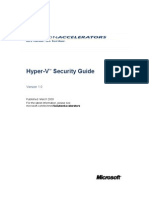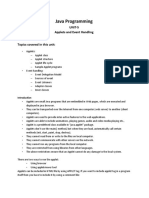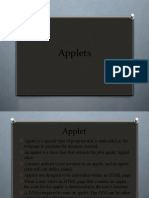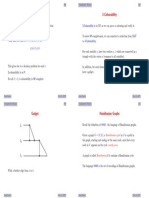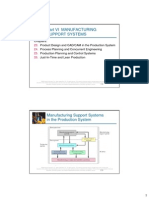Unit Vii Applets & Swings
Unit Vii Applets & Swings
Uploaded by
Falak JaniCopyright:
Available Formats
Unit Vii Applets & Swings
Unit Vii Applets & Swings
Uploaded by
Falak JaniOriginal Description:
Copyright
Available Formats
Share this document
Did you find this document useful?
Is this content inappropriate?
Copyright:
Available Formats
Unit Vii Applets & Swings
Unit Vii Applets & Swings
Uploaded by
Falak JaniCopyright:
Available Formats
UNIT VII APPLETS AND SWINGS
UNIT VII APPLETS AND SWINGS
An applet is a window based program. The applet class provides the necessary support for applet.All applets are subclasses of Applet class. The applet class is defined in the java.applet package. Therefore all applets must import java.applet package ,Applets must also import java.awt package(abstract window toolkit) since all applets run in a window , it is necessary to include support for that window. Applets are not executed by the console based java runtime interpreter rather they are executed by either an applet viewer or a web browser t is the small aplication. !enerally applets are used for internet application. t can be downloaded in internet by java compatiable web browser just like an vidio , audio files. t is more secure,you can download it without any fear of virus attacks, because java is more secure. Applet class hierarchy
Two Types of Applets The first are those based directly on the Applet class. These applets are use the abstract window toolkit(A"T) to provide the graphic user interface. This style of applet has been available since java was first created The second type of applets are based on the swing class #Applet. $wing applets use the swing classes to provide the !% . $wing offers a richer and often easier&to&use user interface that does the awt. Thus, swing&based applets are now the most popular
7.1
Prepared by PHANI KISHORE ROMPICHRLA
UNIT VII APPLETS AND SWINGS
Local Applets A local applet is one that is stored on your own computer system . "hen your "eb page must find a local applet, it doesn't need to retrieve information from the nternet&in fact, your browser doesn't even need to be connected to the nternet at that time. As you can see infigure, a local applet is specified by a path name and a file name.
Remote Applets A remote applet is one that is located on another computer system ((igure ).*). This computer system may be located in the building next door or it may be on the other side of the world&it makes no difference to your #ava&compatible browser. +o matter where the remote applet is located, it's downloaded onto your computer via the nternet.
Differences between applet an application ,. Applets can be embedded in -T./ pages and downloaded over the nternet whereas Applications have no special support in -T./ for embedding or downloading. *. Applets can only be executed inside a java compatible container, such as a browser or appletviewer whereas Applications are executed at command line by java.exe or jview.exe. ). Applets execute under strict security limitations that disallow certain operations (sandbox model security) whereas Applications have no inherent security restrictions. 0. Applets don1t have the main() method as in applications. nstead they operate on an entirely different mechanism where they are initiali2ed by init(),started by start(),stopped by stop() or destroyed by destroy(). 3. Applets are designed just for handling the client site problems. while the java applications are designed to work with the client as well as server 4. Applets are not capable of reading and writing the user's file system. This means that the
7.2 Prepared by PHANI KISHORE ROMPICHRLA
UNIT VII APPLETS AND SWINGS
applet neither can access nor place anything locally. 5. Applets are not capable of communicating the server than one from which they are originating.
Lifecycle of
Applet
"hen an applet begins, the following methods are called, init() start() paint() "hen an applet is terminated, the following se6uence of method calls take place stop() destroy() init! " The init! " method is the first method to be called. This is where you should initiali2e variables. This method is called only once during the run time of your applet. start! " The start! " method is called after init! ". t is also called to restart an applet after it has been stopped. "hereas init! " is called once7the first time an applet is loaded7 start! " is called each time an applet1s -T./ document is displayed onscreen. $o, if a user leaves a web page and comes back, the applet resumes execution at start! ". paint! "
7.3 Prepared by PHANI KISHORE ROMPICHRLA
UNIT VII APPLETS AND SWINGS
The paint! " method is called each time your applet1s output must be redrawn. This situation can occur for several reasons. (or example, the window in which the applet is running may be overwritten by another window and then uncovered. 8r the applet window may be minimi2ed and then restored. paint! " is also called when the applet begins execution. "hatever the cause, whenever the applet must redraw its output, paint! " is called. The paint! " method has one parameter of type Grap#ics. This parameter will contain the graphics context, which describes the graphics environment in which the applet is running. This context is used whenever output to the applet is re6uired stop! " The stop! " method is called when a web browser leaves the -T./ document containing the applet7when it goes to another page, for example. "hen stop! " is called, the applet is probably running. 9ou should use stop! " to suspend threads that don1t need to run when the applet is not visible. 9ou can restart them when start! " is called if the user returns to the page . estroy! " The estroy! " method is called when the environment determines that your applet needs to be removed completely from memory. At this point, you should free up any resources the applet may be using. The stop! " method is always called before estroy! ". E$ample Applet Pro%ram& import java.awt.:; import java.applet.:; public class Ap extends Applet < public void paint(!raphics g) < (ont f=new (ont(>arial>,(ont.?8/@,*A); g.set(ont(f); set?ackground(Bolor.!CDD+); g.draw$tring(> m your friend>,,A,,A); E E F:Gapplet code=Ap width=,AA height=,AAH GFappletH :F Passin% Parameters to Applets The AII/DT tag in -T./ allows you to pass parameters to your applet. To retrieve a parameter, use the %etParameter! " method. t returns the value of the specified parameter in the form of a Strin% object. Thus, for numeric and 'oolean values, you will need to convert their string representations into their internal formats. -ere is an example that demonstrates passing parametersJ
7.4 Prepared by PHANI KISHORE ROMPICHRLA
UNIT VII APPLETS AND SWINGS
DxampleJ import java.awt.:; import java.applet.:; public class Iaram@emo extends Applet < public void paint(!raphics g) FF @isplay parameters. < int x = nteger.parse nt(getIarameter(KaL)); int y = nteger.parse nt(getIarameter(KbL)); g.draw$tring(>sum is >M(xMy), A, ,A); E E F:Gapplet code=>Iaram@emo> width=)AA height=NAH Gparam name=a value=,AH Gparam name=b value=,0H GFappletH :F Swin%s $wing is not an acronym. The name represents the collaborative choice of its designers when the project was kicked off in late ,OO4. $wing is actually part of a larger family of #ava products known as the #ava (oundation Blasses ( #(B), which incorporate many of the features of +etscape's nternet (oundation Blasses ( (B) as well as design aspects from ?.'s Taligent division and /ighthouse @esign. $wing has been in active development since the beta period of the #ava @evelopment Pit ( #@P) ,.,, circa spring of ,OO5. $wing contains many more graphical components than its immediate predecessor, A"T. .any are components that were scribbled on programmer wishlists since #ava first debuted including tables, trees, internal frames, and a plethora of advanced text components. n addition, $wing contains many design advances over A"T. (or example, $wing introduced an Action class that makes it easier to coordinate !% components with their functionality. 9ou'll also find that a much cleaner design prevails throughout $wing; this cuts down on the number of unexpected surprises that you're likely to face while coding Swin% (eat)res $wing provides many features for writing large&scale applications in #ava. -ere is an overview of some of the more popular features. Pluggable Look-and-Feels 8ne of the most exciting aspects of the $wing classes is the ability to dictate the /Q( of each of the components, even resetting the /Q( at runtime. /Q(s have become an important issue in !% development over the past ,A years. .any users are familiar with the .otif style of user
7.5 Prepared by PHANI KISHORE ROMPICHRLA
UNIT VII APPLETS AND SWINGS
interface, which was common in "indows )., and is still in wide use on %nix platforms.
.icrosoft created a more optimi2ed /Q( in their "indows O3FONF+TF*AAA operating systems. n
addition, the .acintosh computer system has its own carefully designed /Q(, which most Apple users feel comfortable with. Lightweight Components .ost $wing components are lightweight. n the purest sense, this means that components are not dependent on native peers to render themselves. nstead, they use simplified graphics primitives to paint themselves on the screen and can even allow portions to be transparent. Additional Features $everal other features distinguish $wing from the older A"T componentsJ $wing has wide variety of new components, such as tables, trees, sliders, spinners, progress bars, internal frames, and text components. $wing components support the replacement of their insets with an arbitrary number of nested borders. $wing components can have tooltips placed over them. A tooltip is a textual pop up that momentarily appears when the mouse cursor rests inside the component's painting region. Tooltips can be used to give more information about the component in 6uestion. 9ou can arbitrarily bind keyboard events to components, defining how they react tovarious keystrokes under given conditions. There is additional debugging support for rendering your own lightweight $wing components T#e *o el+View+,ontroller Arc#itect)re $wing uses the model-view-controller architecture (.RB) as the fundamental design behind each of its components. Dssentially, .RB breaks !% components into three elements. Dach of these elements plays a crucial role in how the component behaves. Model The model encompasses the state data for each component. There are different models for different types of components. (or example, the model of a scrollbar component might contain information about the current position of its adjustable >thumb,> its minimum and maximum values, and the thumb's width (relative to the range of values). A menu, on the other hand, may simply contain a list of the menu items the user can select from. This information remains the same no matter how the component is painted on the screen; model data is always independent of the component's visual representation. View The view refers to how you see the component on the screen. (or a good example of how views can differ, look at an application window on two different !% platforms. Almost all window
7.6 Prepared by PHANI KISHORE ROMPICHRLA
UNIT VII APPLETS AND SWINGS
frames have a title bar spanning the top of the window. -owever, the title bar may have a close box on the left side (like the .ac 8$ platform), or it may have the close box on the right side (as in the "indows platform). These are examples of different types of views for the same window object. Controller The controller is the portion of the user interface that dictates how the component interacts with events. Dvents come in many forms 7 e.g., a mouse click, gaining or losing focus, a keyboard event that triggers a specific menu command, or even a directive to repaint part of the screen. The controller decides how each component reacts to the event7if it reacts at all.
E$ample of Swin% pro%ram& import java.awt.:; import javax.swing.:; import java.awt.event.:; public class #?@emo extends #Applet implements Action/istener < #?utton b,,b*; public void init() < Bontainer c=getBontentIane(); c.set/ayout(new (low/ayout((low/ayout.BD+TDC)); b,=new #?utton(KyesL); b*=new #?utton(KnoL); c.add(b,); c.add(b*); b,.addAction/istener(this); b*.addAction/istener(this); E public void actionIerformed(ActionDvent e) < show$tatus(e.getActionBommand()); E E F:Gapplet code=L#?@emo.classL width=)AA height=*3AH:F outputJ
7.7
Prepared by PHANI KISHORE ROMPICHRLA
You might also like
- Hyper-V Security GuideDocument42 pagesHyper-V Security GuideRohit KamleNo ratings yet
- Anatomy of Credit Card NumbersDocument5 pagesAnatomy of Credit Card NumbersAftab Saad100% (1)
- Java NotesDocument48 pagesJava NotesDaniel JoshuaNo ratings yet
- Unit 1 The Applet ClassDocument9 pagesUnit 1 The Applet ClassNirmal NeupaneNo ratings yet
- Unit 1 Applets: Structure Page NosDocument20 pagesUnit 1 Applets: Structure Page NosxbabaxNo ratings yet
- JAVA Unit 3Document186 pagesJAVA Unit 3momap92001No ratings yet
- Java Applets: The HTML Page Must Tells The BrowserDocument16 pagesJava Applets: The HTML Page Must Tells The Browservedant kulkarniNo ratings yet
- Unit VDocument51 pagesUnit Vuday franklinNo ratings yet
- Java AppletDocument26 pagesJava AppletDaksh MathurNo ratings yet
- Chapter 4: Applets and Application: 4.1. Applet FundamentalsDocument12 pagesChapter 4: Applets and Application: 4.1. Applet FundamentalsSujan NeupaneNo ratings yet
- Chapter 5Document31 pagesChapter 5R JadhavNo ratings yet
- Unit 3 Applets: Structure Page NosDocument20 pagesUnit 3 Applets: Structure Page NosMala MishraNo ratings yet
- Applets: Applet Programs Application ProgramsDocument21 pagesApplets: Applet Programs Application ProgramspraveeNo ratings yet
- UNIT-I AppletDocument11 pagesUNIT-I AppletYog RudraNo ratings yet
- Java Programming Chapter IIDocument13 pagesJava Programming Chapter IImersimoybekele88No ratings yet
- EContent 11 2024 09 22 22 46 48 Unit1 JavaAppletspptx 2024 07 25 09 14 11Document43 pagesEContent 11 2024 09 22 22 46 48 Unit1 JavaAppletspptx 2024 07 25 09 14 11chandaranadhruv9No ratings yet
- Bca 2 Year Java Eng Unit 5Document14 pagesBca 2 Year Java Eng Unit 5Vikas PareekNo ratings yet
- Java Applets & Graphics ProgrammingDocument19 pagesJava Applets & Graphics ProgrammingTejaswini MahajanNo ratings yet
- Java Programming: UNIT-5 Applets and Event Handling Topics Covered in This UnitDocument40 pagesJava Programming: UNIT-5 Applets and Event Handling Topics Covered in This UnitSrinivas TNo ratings yet
- OOP Through Java Unit - 5Document14 pagesOOP Through Java Unit - 5bhanubhaithurakalaNo ratings yet
- Java Unit-5Document36 pagesJava Unit-5RakeshNo ratings yet
- Module IV AppletsDocument27 pagesModule IV AppletsTeja NayiraNo ratings yet
- Java Programming Ch5 Ch6Document30 pagesJava Programming Ch5 Ch6nimbalkarvikram966No ratings yet
- AppletDocument83 pagesAppletddivaaNo ratings yet
- Modern Programming Tools and Techniques-I: Lovely Professional University, PunjabDocument44 pagesModern Programming Tools and Techniques-I: Lovely Professional University, Punjabkethu2403No ratings yet
- Applet ProgrammingDocument12 pagesApplet ProgrammingMadhu SudhanNo ratings yet
- Advanve Java BookDocument296 pagesAdvanve Java BookbhuvneshNo ratings yet
- Applet File Online OneDocument6 pagesApplet File Online Oneaaryanbhatnagar04No ratings yet
- Unit 6Document7 pagesUnit 6yicet13049No ratings yet
- AppletDocument37 pagesAppletsureshNo ratings yet
- Java Programming Unit - IvDocument26 pagesJava Programming Unit - Ivb1974No ratings yet
- 320243-Unit No.5-JPRDocument32 pages320243-Unit No.5-JPRabhaysonone0No ratings yet
- 17cs42 Mod5 PDFDocument44 pages17cs42 Mod5 PDFNikithaNo ratings yet
- AppletsDocument21 pagesAppletsKumar Kaushal 040No ratings yet
- Applet & Event Handling PDFDocument38 pagesApplet & Event Handling PDFlabhneshjNo ratings yet
- Event HandlingDocument64 pagesEvent Handlinguddagiri sirishaNo ratings yet
- Unit 1Document10 pagesUnit 1Rahul PatelNo ratings yet
- Object-Oriented Programming: Computer Science Year IIDocument18 pagesObject-Oriented Programming: Computer Science Year IIGebreigziabher M. AbNo ratings yet
- Applet JAVA Update2Document64 pagesApplet JAVA Update2minermr781No ratings yet
- Fepj - 4Document46 pagesFepj - 4Ankush ThakurNo ratings yet
- AppletsDocument21 pagesAppletsSonali EkatpureNo ratings yet
- Unit IDocument11 pagesUnit Imoaz.sheikh11No ratings yet
- Java Programming Chapter IIDocument10 pagesJava Programming Chapter IIdejenehundaol91No ratings yet
- Unit 2. Introduction To JavaDocument35 pagesUnit 2. Introduction To JavaAllia Danielle D. Asuncion-UmaliNo ratings yet
- 4 1 AppletDocument31 pages4 1 Appletvinay.niranjan006No ratings yet
- APPLET PROGRAMMING and GRAPHICSDocument45 pagesAPPLET PROGRAMMING and GRAPHICSswapnil kaleNo ratings yet
- Chapter 1 AppletsDocument8 pagesChapter 1 AppletsYassab AzizNo ratings yet
- Chap11 Applets FinalDocument14 pagesChap11 Applets FinalRajan SahotaNo ratings yet
- Java Applet: Navigation SearchDocument8 pagesJava Applet: Navigation Searchgowtham7pulseNo ratings yet
- Applets in JavaDocument13 pagesApplets in JavaSANIDHYSINGH RAGHUWANSHINo ratings yet
- JAVA Unit 6Document48 pagesJAVA Unit 6SRHNo ratings yet
- Java Unit 3Document9 pagesJava Unit 3Yashwanth katlaNo ratings yet
- Applet Basics Applet Basics Applet BasicsDocument29 pagesApplet Basics Applet Basics Applet Basicsbalaji024024No ratings yet
- Applet-HTML Programming2018Document66 pagesApplet-HTML Programming2018pradnya sadigaleNo ratings yet
- VIPS OOPS Unit 3 AppletDocument24 pagesVIPS OOPS Unit 3 Appletnishtha.kansalNo ratings yet
- Java AWTDocument8 pagesJava AWTAnshu PriyaNo ratings yet
- Applet ProgrammingDocument8 pagesApplet ProgrammingSharon Stefi GHNo ratings yet
- Chapter-2 Java AppletDocument26 pagesChapter-2 Java AppletNaoly GetNo ratings yet
- Seminar Paper On Java AppletsDocument16 pagesSeminar Paper On Java AppletsOgbodo Emeka A100% (1)
- Java Unit-5Document35 pagesJava Unit-5syeda husnaNo ratings yet
- MCA (Revised) Term-End Practical Examination December, 2011: No. of Printed PagesDocument4 pagesMCA (Revised) Term-End Practical Examination December, 2011: No. of Printed PagesFalak JaniNo ratings yet
- k -Colourability 3-Colourability: G = (V, E) χ: V → (1, - . -, k) u, v ∈ V (u, v) ∈ E χ (u) 6= χ (v) 3-ColourabilityDocument3 pagesk -Colourability 3-Colourability: G = (V, E) χ: V → (1, - . -, k) u, v ∈ V (u, v) ∈ E χ (u) 6= χ (v) 3-ColourabilityFalak JaniNo ratings yet
- Unit Vi Event HandlingDocument5 pagesUnit Vi Event HandlingFalak JaniNo ratings yet
- Unit III InheritanceDocument23 pagesUnit III InheritanceFalak JaniNo ratings yet
- Selection SortDocument5 pagesSelection SortFalak JaniNo ratings yet
- Calculation of Postfix ExpressionDocument2 pagesCalculation of Postfix ExpressionFalak JaniNo ratings yet
- Retail ViVA BrochureDocument26 pagesRetail ViVA Brochuresantosh kumarNo ratings yet
- Steal This Presentation!Document72 pagesSteal This Presentation!iknowjesse100% (1)
- Signals and Systems Model - 1Document2 pagesSignals and Systems Model - 1sharanyameen2704No ratings yet
- Improvement of Neurofuzzy Systems Using K-Means Clustering: Dr. Rafiqul Zaman Khan Md. Haider Khalaf JabbarDocument7 pagesImprovement of Neurofuzzy Systems Using K-Means Clustering: Dr. Rafiqul Zaman Khan Md. Haider Khalaf JabbarYume YumeNo ratings yet
- Difference Between - Descriptive Analysis and ComparisonsDocument1 pageDifference Between - Descriptive Analysis and ComparisonsOmair Socor AbangonNo ratings yet
- Assignment 2Document6 pagesAssignment 2Ana RomanNo ratings yet
- Godzilla: Seamless 2D and 3D Sketch Environment For Reflective and Creative Design WorkDocument8 pagesGodzilla: Seamless 2D and 3D Sketch Environment For Reflective and Creative Design Worksinghishpal24374No ratings yet
- Maths Refresher Workbook Class 1Document42 pagesMaths Refresher Workbook Class 1RRaiNo ratings yet
- Twyncat: Twincat ST (Structured Text) LanguageDocument5 pagesTwyncat: Twincat ST (Structured Text) LanguageanhossainNo ratings yet
- Using Java To Access CA-DatacomDocument36 pagesUsing Java To Access CA-DatacommbuyiselwaNo ratings yet
- 6.5.11 Modify Existing Point - Via Reconstitute MethodDocument2 pages6.5.11 Modify Existing Point - Via Reconstitute MethodFrediNo ratings yet
- 9780134048192Document79 pages9780134048192AS BAKA100% (1)
- DP67BG PerfTuningGuideDocument32 pagesDP67BG PerfTuningGuidepresentaciones_2012No ratings yet
- VLSI Physical Design: From Graph Partitioning To Timing ClosureDocument30 pagesVLSI Physical Design: From Graph Partitioning To Timing ClosurekamarajvlsiNo ratings yet
- Star BurnDocument6 pagesStar BurnRudy Nikoi AddoNo ratings yet
- New Microsoft Office Word DocumentDocument3 pagesNew Microsoft Office Word Documentprojectcentre10No ratings yet
- From Visual Import : AballinaboxDocument7 pagesFrom Visual Import : AballinaboxhammouNo ratings yet
- Mikell P. GrooverDocument15 pagesMikell P. GrooverRizal Nur IkhwaniNo ratings yet
- Spoken Language Processing in Python Chapter2Document23 pagesSpoken Language Processing in Python Chapter2FgpeqwNo ratings yet
- VDI Deployment StrategyDocument14 pagesVDI Deployment StrategyAlejandro Daricz100% (1)
- Same VLAN On Switch and Router With EtherSwitch ModuleDocument28 pagesSame VLAN On Switch and Router With EtherSwitch Moduledenis_rodriguezNo ratings yet
- ResumeDocument4 pagesResumeMonu MehtaNo ratings yet
- Alcohol Detection Helmet and Smart HelmetDocument4 pagesAlcohol Detection Helmet and Smart HelmetSahil DhirNo ratings yet
- 4-Distributed Arithmetic SDDocument13 pages4-Distributed Arithmetic SDinturi venkata gopichandNo ratings yet
- Dfsurdg 1Document613 pagesDfsurdg 1Siranjeevi MohanarajaNo ratings yet
- German UniversityDocument5 pagesGerman UniversitynehalNo ratings yet
- 4 FEM - Lect2Document113 pages4 FEM - Lect2sandeepNo ratings yet
- Seven Categories of The Business CriteriaDocument17 pagesSeven Categories of The Business CriteriaNitin KumarNo ratings yet
